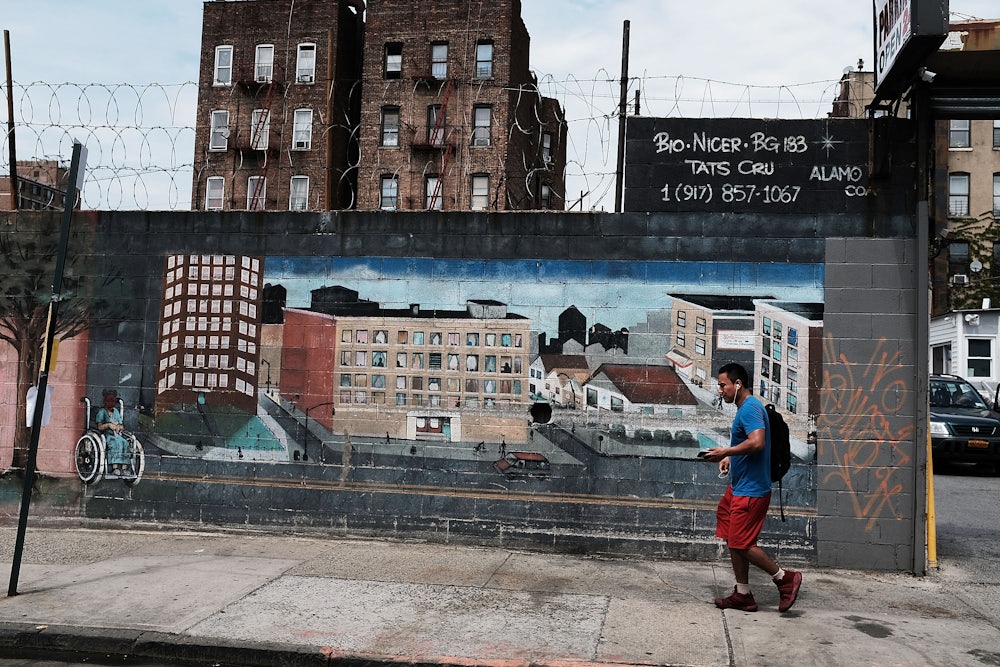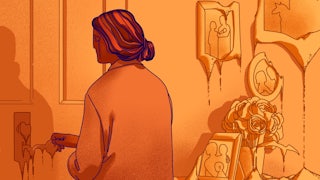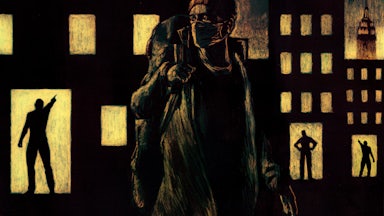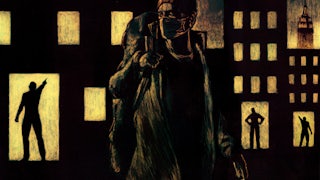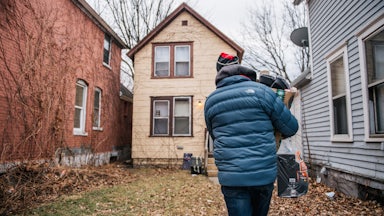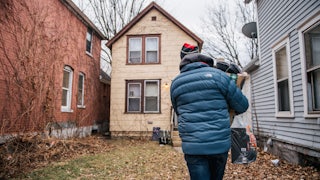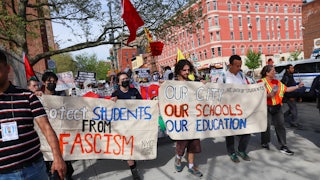On a still, dew-damp morning in November, Karen Washington, 65, moved fluidly from the greenhouse to a wooden picnic table at the Garden of Happiness in the Bronx, plastic bucket in hand. The bucket was half-full of sage, lavender, thyme—herbs grown in what used to be the rubble of a burned-out apartment building. Stooping at a planter’s box of mint, she snipped an armful of lush stalks, laden with rich, green leaves, and wrapped them with a rubber band. A few garden plots, as big as queen-size beds, yielded hot peppers, green tomatoes, and stubborn last squashes; others were stripped bare already, prepped for winter sleep by fellow garden members. The chickens in their roomy enclosure had already been fed—Washington walks across the street each morning at 7 a.m. to feed them—and were gossiping amiably as they pecked the ground. La Familia Verde, the farmer’s market that Washington runs a few blocks away, stocked with vegetables from this garden and New York State farms, would open soon, and there was plenty to be done. There is always plenty to be done for Washington, a physical therapist who became a guru in the food justice world, feted by Jill Biden, Forbes, Ebony, and the James Beard Foundation as the godmother of Black urban farming.
“Alright, we gotta go,” she said as she hoisted painters’ pails of collards and moved under a grape arbor down a brick path to the chain-link gate. Today would be her last market. After nearly 40 years on Prospect Avenue and 181st Street, in the Crotona section of the Bronx just southwest of the Bronx Zoo, Washington was moving to Atlanta, where her daughter, son-in-law, and grandchildren are. Washington has been a key figure on the block since she arrived, part of a cohort that bought low-cost homes through a city program in the 1980s. She is one of three homeowners in a single row—all Black women, seniors now—who’ve sold their homes this year and are leaving for the South. Their reasons are prosaic: grandchildren, the lure of mild winters, wariness about rising crime, lessons drawn from Covid-19 about the need to be close to family—but the fact of their departure notes the end of a season in the Bronx.
“The chapter’s closed. And then, you know, it needs new voices. I’m like the old guard. The old guard’s got to step aside so we can hear new voices,” Washington said, her voice still carrying the cadence of the South her parents fled in the 1940s. When Washington and her neighbors moved to Prospect Avenue in the 1980s, the Bronx was just beginning to climb out of the devastation of landlord arson that was the culmination of redlining, urban renewal, New York’s fiscal crisis, and the perverse incentives of an insurance system that made buildings more valuable as fire losses than as places to live. The homeownership initiative that helped Washington buy her home worked to stabilize the neighborhood, and it built wealth—Black wealth—for people more often exploited by the financial system. Washington and her neighbors sold their houses at a profit and are using the wealth they accrued over 40 years to furnish another life, a good retirement. Washington will use what she gained from the sale of her house to buy land she’ll farm in the South.
The days of fires and abandonment are well past in Crotona. Instead, the neighborhood and the rest of the Bronx face a different crisis. Property is worth too much. Owner-occupied homes similar to Washington’s are being sold for their tear-down value and replaced with hastily built high rises that make someone else rich. Century-old apartment buildings housing hundreds of working poor families attract international capital, private equity funds, and corporate landlords, which conceive of the buildings not as places to live but as financial tools, shells for debt and leverage for greater acquisition, according to a 2020 report by the Community Service Society of New York. For the past decade, banks have underwritten mortgages on Bronx buildings worth many times the income the buildings produce in rent, an arrangement tempting catastrophe, the report found. Strengthened tenant protections adopted in 2019 by a newly activist New York state legislature and an eviction moratorium extended several times during the Covid-19 pandemic have been a reprieve for renters, but landlords who bought up buildings at speculative prices, gambling on ever-increasing rents—and quite literally banking on the ability to oust low-income tenants—are faced with declining buildings they can’t afford to maintain and investors they are obliged to serve.
In Crotona, one in three tenants pay more than 50 percent of their income in rent, according to the Furman Center for Real Estate and Urban Policy at NYU. Breathtakingly exploitative conditions are common: undocumented people renting unlit basements; three-bedroom apartments subdivided into rabbit-warren firetraps; and until recently, whole buildings turned over from rent-regulated housing to carceral and remunerative shelters to house New York’s massive homeless population, at fat reimbursements from the city. Crotona had the densest concentration of such privately owned cluster-site shelter buildings in the city, 20 percent of the city’s entire collection, according to a 2018 analysis conducted for the Mary Mitchell Family and Youth Center, a local community organization. (The city ended the program completely in the fall of 2021 and arranged the sale of four of the Crotona buildings to a local nonprofit, which will keep them at affordable prices in perpetuity; the other 24 are still owned privately and while the apartments have reverted to rent regulation, they are in poor shape, riddled with housing code violations.
What would a successful, wealth-building housing program look like today? It’s worth examining what was done before. Between 1970 and 1980, Crotona had lost more than 6,000 units of housing (46 percent) and nearly 30,000 (59 percent) of its residents to flight—white and otherwise. The borough as a whole lost 100,000 people during that decade. In an effort to do something about it, in 1981, a partnership between the Department of Housing and Urban Development and the City of New York financed the construction of 200 single-story red brick homes within a few blocks along Prospect and nearby Mapes and Clinton Avenues. The homes, built by a private developer, were just one of dozens of similar projects launched in the south Bronx in the 1980s. The houses were sold for $50,000, with the aim of bringing people back to the neighborhood while paving a way into the middle class for people like Washington. Owners had to agree to stay for 20 years before selling.
Cheryl Holt grew up in the Bronx and until this fall had never left. She sat at La Familia Verde farmers market on this November morning cleaning the papery outside layers off bunches of scallions and gestured with her outstretched arm like a compass pointing to each of the places she’d lived nearby. In the early 1980s, she was a student at City College, working nights in the back office at Bankers Trust. “At those times, they had the teletape machine and we had to put in the numbers of the dividend checks. That’s when I realized, my God, people are making so much money,” she said. “I’d get on the train after that, the quarter-to-three Third Avenue El, middle of the night, back to the Bronx. I remember getting off the train and smelling the smoke. You would just pray it wasn’t your building. They were burning the Bronx down.”
On the advice of her daughter’s godmother, she bought one of the houses on Prospect Avenue, next door to Washington. Holt became a gym teacher, then a dean at high schools in Harlem and the Bronx. When she retired, in June, she’d been running a night school program. She raised her own children in the house and devoted herself to the neighborhood. Now, with the proceeds from the sale of her Prospect Avenue house, she has bought a condo outside Fort Lauderdale and has a cushion to live on left over. The development she’s moving into, she said, has “pools, golf courses, club houses, everything. Shows. Last weekend, I think they had The Platters down there.”
Owning their homes and reaping the benefit of low mortgage payments afforded people like Holt stability and reprieve. “I just have to say thank you, Freddie Ferrer,” Washington said, naming the Bronx borough president who oversaw the completion of the houses after the initial developer ran out of money and building stalled. Washington raised her children on 181st and Prospect, started the garden, and joined neighbors in the Crotona Community Association who had pushed to get the houses finished and demanded the return of city services and investment. It worked. Crotona is still among the poorest neighborhoods in the city—40 percent of households earn less than $20,000 a year, and the median income in the neighborhood is 66 percent lower than that of the city as a whole, according to the Furman Center—but the work begun in the 1980s took root. By the mid-1990s, the neighborhood had been transformed, vacant lots and derelict buildings replaced with small homes, nonprofit and tenant-owned apartment buildings, gardens, a Bronx Field of Dreams ball field.
The people in Crotona keep surviving. But today’s leaders are trying to envision a new way forward, at a time when property values have soared and it seems unthinkable that the government would build and finance the purchase of so many new homes. When Wanda Salaman arrived in Crotona from rural Puerto Rico as a child in the 1980s, she found it disorienting how often people moved, driven from apartment to apartment by high rent, poor conditions, and fire. At home her family had been rooted to their patch of land for generations. She wants people to be able to put down deep roots in the Bronx. Throughout the pandemic, she ran virtual support groups with her organization, Mothers on the Move, helped tenants organize against negligent landlords, managed weekly food distribution for 300 families in collaboration with the Mary Mitchell Center, and coordinated rides for elderly people to vaccine appointments. But she’d like to be looking at the horizon. “I’m tired of putting out fires,” Salaman said. “When are we going to really help people?” She wants the type of opportunity afforded Washington and Holt made available to others today. “They were able to build wealth. If anybody else wants to build wealth in NYC today, it’s impossible. It’s too expensive.”
An answer might lie in some of the most problem-plagued buildings in Crotona, Salaman said. She argues that the neighborhood’s cluster-site shelter buildings, where until recently the city paid private owners far above market rate to house homeless people, should be turned into low-income co-ops with the residents getting assistance to own the apartments. It could be more price-effective than paying landlords to run shelters, and it would give residents a chance at their own permanent homes. The cluster-site buildings and many of those purchased with speculative mortgages need extensive rehabilitation. Salaman envisions using climate provisions in the Build Back Better legislation (if it passes) to fund green rehabs that move poorly run buildings into local ownership.
According to Edward Garcia, the banks that are underwriting sky-high mortgages on run-down buildings where poor people live have a lot to answer for. “I think there is a responsibility on the part of the banks that are underwriting these overleveraged sales. They haven’t been made responsible for the damage they’ve created in the community,” he said. Garcia, lean and precise, graduated City College in 2019 with a degree in political science. He’s been involved with the Northwest Bronx Community and Clergy Coalition since he arrived from Santo Domingo as a teenager. As director of community development for the group, he keeps a list of Bronx properties that have fallen into city ownership or are in the city’s tax lien sale, where unpaid taxes are sold as a debt investment. Debt investors are then empowered to collect on the lien, and often end up owning the property. City-owned liens, Garcia says, should instead be transferred to community land trusts, which work on a model of shared ownership, as a means to move property out of the cycle of boom and bust, speculation and abandonment. Advocates for community land trusts and others argue the city’s tax lien sale—instituted in the 1990s as a means of realizing income from delinquent properties—should be abolished. Incoming Mayor Eric Adams has pledged to do so, and the new city comptroller, Brad Lander, has proposed transferring properties that default on mortgages or rack up unpaid taxes into a community land bank and then to land trusts.
There is also legislation before the New York City Council that would give community land trusts the right of first refusal on distressed properties, but without dramatic intervention they’ll never have the deep pockets to compete with private investors, Garcia said. Nonprofit hospitals are required to invest a portion of their endowments in communities they serve, he noted, so “some folks have talked about leveraging hospital reinvestment dollars for this kind of private acquisition or rehab.” Public pension funds could contribute, as well, Garcia suggested. “There are a lot of funding sources that would require a lot of organizing around but could be super useful in helping CLTs succeed.”
Critics call ideas like these utopian, far-fetched. But bounty from a Bronx block once seemed impossible, too.
